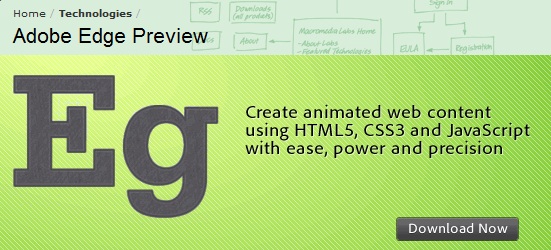Devs respond to Adobe Edge
We speak to leading developers about the newly released web animation tool, and discover concerns over HTML5 branding and absence of SVG and canvas, although Adobe stresses it’s still early days
Developers have now had a day to explore and evaluate the first preview of Adobe's new web animation software, Edge. In general people are appreciative that Adobe is putting the software out there in its early stages of development so that it can be built based on feedback, but some concerns have been raised.
The main area of controversy surrounds the use of divs for animated elements instead of SVG or canvas. It's important to remember that this is an early prototype, but it's being marketed as an HTML5 tool, so people are surprised to find there's not actually much in the way of HTML5.
Mozilla technical evangelist Rob Hawkes is pleased that Edge exists, but is worried that promoting old technologies could cause trouble. He told .net: "I appreciate that what they've created is a pre-release tool, but I'm concerned about their outlook on animation with HTML and JavaScript. My opinion boils down to the issue surrounding their use of div elements for animation, rather than embracing the more suitable technologies like canvas and SVG. It would be great to see Adobe take this feedback on board and do things the right way by using the newer technologies by default, then falling back to other technologies as and when appropriate, with DOM-based animation as a last resort.
"Right now I compare this situation to the way tables were used for layout before CSS saved the day. In this situation div-based animation represent tables, and the newer technologies like canvas and SVG represent CSS. We must adopt and promote the right tools for the job.
"I'm looking forward to seeing how Edge progresses, but Adobe need to be careful that they don't take us a step in the wrong direction; that could cause headaches for the developer community for years.
“I know that myself and others would love to communicate with Adobe to help make this a success. The developer community really needs a good tool like this to help bring JavaScript animation to the mainstream. Adobe are in a great position to make some impact here."

Hawkes put his concerns to Adobe on the Edge forum, to which Josh Hatwich, senior computer scientist at Adobe, responded: “We started with DIVs because we wanted to get something out there quickly that folks could play with. I say we ‘started’ there because Edge will be evolving rapidly — the product is by no means feature complete.
Get the Creative Bloq Newsletter
Daily design news, reviews, how-tos and more, as picked by the editors.
“We expect to add support for more and more of the HTML universe over time. The good news is that our JS runtime is capable of animations that include all sorts of HTML Elements, SVG elements and even Canvas graphics, so we have not boxed ourselves in."
Mark Anders, a Fellow at Adobe, expanded on the reasons for excluding canvas and SVG from the first preview: "We seriously considered Canvas, but current performance on mobile browsers (especially iOS) is very bad. We didn't want to have the first experience produce content that couldn't run acceptably. Note that this may be changing in iOS 5, so that's good. Finally, SVG can be a little slow, though we do support bringing in SVG elements and animating them — just not reach into them."
You can follow the full discussion over on the Edge Forum.
Consultant Seb Lee-Delisle wonders why there aren't more features at this stage, and who exactly Edge is aimed at. "Adobe announced their newfound love for HTML at last year's MAX in October, so nearly a year later I would expect a much more mature tool,” he told .net.
"It uses jQuery to move DIV elements around, which is a very backwards compatible method. Having said that, jQuery doesn't enable rotation and scaling in IE8, so Edge is not compatible with that browser. And if it's not going to work on IE8 they should probably look at more modern ways of doing this.
"I personally would prefer to see SVG elements rather than divs, although that would depend on what the use case for this would be.
"And that's the big question: who and what is this for? It's going to be impossible to create a quality targeted tool until you define exactly what this tool should be used for and by whom. And right now it feels unfocused and it's not at all clear what problems this tool is supposed to solve."

Front end developer Anna Debenham echoed this last point in her blog post: "I'm left wondering what sort of things people will find Edge useful for. I hope not just as a selling point by web agencies as an alternative to Flash ads."
She also expressed disappointment that it's being marketed as an HTML5 tool: "The only thing I can see in the code that is HTML5 is the doctype."
The suspicion that Edge might be aimed mostly at advertisers was also mentioned in Rob Hawkes's forum posts, and he too was displeased by the HTML5 marketing. But both are happy about Adobe's efforts to engage with developer feedback.
Bruce Lawson, web standards evangelist at Opera, told .net: "I think it's a good move from Adobe, and one that's been widely expected for a couple of years now. Now motion graphics are increasingly rendered via the Open Web Stack (HTML, CSS, JavaScript, SVG, WebGL) rather than a single-vendor plug-in, designers will require authoring tools that can help them turn their creativity into code, and Adobe have a great track record on making IDEs that designers find user-friendly.
"It's early days yet, and it remains to be seen how cross-browser and lightweight the resulting code will be in the final release, but I tentatively declare it a win for the open web stack and a win for designers (and developers like me) who find scripting animations in a text editor keeps them awake at night in a cold sweat."
Asked about the marketing tactics, Lawson replied: "It's marketing-speak-HTML5 rather than real HTML5. Many companies' marketing people have realised that if I call my dog ‘HTML5’, it's more likely to win Crufts than if I call it ‘CSS3’ or ‘Open Web Standards’. So everything is ‘HTML5’. It's a shame, but there we are.
In response to questions about the features in Edge, Mark Anders of Adobe emphasised: "The big thing to keep in mind is that this is a Preview 1, not a Version 1, and we will be looking to expand support in future releases.”
Adobe also underlined their commitment to working with the developer community: "We welcome all suggestions and actively encourage people to contribute to the forum."
Get the latest Adobe CS6 review from our sister site Creative Bloq.

Thank you for reading 5 articles this month* Join now for unlimited access
Enjoy your first month for just £1 / $1 / €1
*Read 5 free articles per month without a subscription

Join now for unlimited access
Try first month for just £1 / $1 / €1
The Creative Bloq team is made up of a group of design fans, and has changed and evolved since Creative Bloq began back in 2012. The current website team consists of eight full-time members of staff: Editor Georgia Coggan, Deputy Editor Rosie Hilder, Ecommerce Editor Beren Neale, Senior News Editor Daniel Piper, Editor, Digital Art and 3D Ian Dean, Tech Reviews Editor Erlingur Einarsson, Ecommerce Writer Beth Nicholls and Staff Writer Natalie Fear, as well as a roster of freelancers from around the world. The ImagineFX magazine team also pitch in, ensuring that content from leading digital art publication ImagineFX is represented on Creative Bloq.
